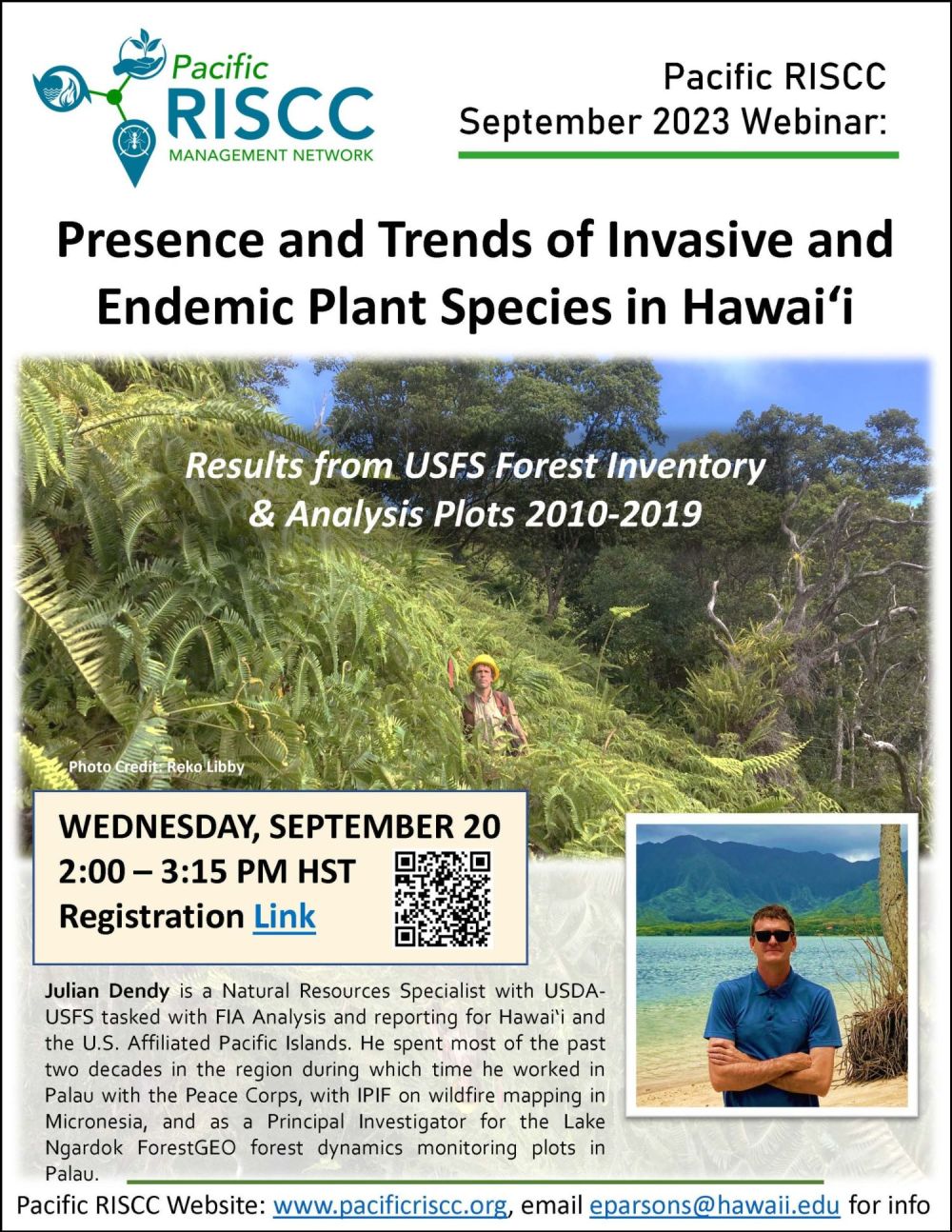Presence and Trends of Invasive and Endemic Plant Species in Hawaiʻi: Results from USFS Forest and Inventory & Analysis Plots 2010-2019
American Sāmoa | Wednesday, September 20 from 1:00-2:15 p.m.Hawaiʻi | Wednesday, September 20 from 2:00-3:15 p.m.Palau | Thursday, September 21 from 9:00-10:15 a.m.CNMI & Guam | Thursday, September 21 from 10:00-11:15 a.m.FSM | Thursday, September 21 from 10:00-11:15 a.m. (Weno) / 11:00 am-12:15 p.m. (Palikir)RMI | Thursday, September 21 from 12:00 – 1:15 p.m.
A Pacific RISCC Webinar via Zoom
Webinar overview:
Vegetation is changing in Hawaiʻi. What are the trends for both endemic and invasive plant species and what does this portend for the future? Julian Dendy from the USDA Forest Service Forest Inventory & Analysis (FIA) program will share their long-term monitoring results from 2010-2019.
September’s Pacific RISCC webinar will feature work from members of the USDA USFS Forest Inventory & Analysis Program:
- Presenter : Julian Dendy
- Co-authors: Olaf Kuegler, Ashley Lehman, & Jonathan Marshall.
Note About Webinar Slides:
From Dendy et al: Please note that some erroneous results were reported in the first version of this presentation that were due to differences in vegetation profile methodology during the first measurement year of the inventory in 2010. Corrected slides with 2010 measured plots removed from analyses are presented in this PDF (link), which was updated on 8/15/24.
Webinar Abstract:
The United States Department of Agriculture Forest Service manages a congressionally mandated Forest Inventory and Analysis (FIA) program, which monitors randomly sampled forest locations over time across the continental U.S., Alaska, Hawaiʻi and US affiliated Pacific and Caribbean Island territories and nations. The program maintains a consistent methodology to assess forest composition, structure, and health at the state level. Forest health measurements include observations of invasive plant species, as defined by official regional invasive species lists.
In 2022, the remeasurement of the Hawaiʻi state forest inventory was completed, and we investigated FIA remeasured plot data to assess trends of invasive and endemic plant species occurrence over roughly the last decade. The confidence level for significant changes in forest occurrence was low (68%) except for the most abundant tree species in Hawaiʻi (Strawberry Guava), and there were more significant changes among invasive plant species than endemics.
There was a large significant relative increase (1/3) in forest area with Strawberry Guava trees present, and a relatively small (2%) relative loss of forest area with ʻōhiʻa trees between inventories (2010-2019). Three other endemic species had significant increases in forest area presence, while roughly a dozen invasive tree species, and a dozen non-tree invasive plant species had significant increases. This was correlated with statewide increases in forest area with any invasive plant species present, total forest area covered by invasive plant species, disturbed forest area, and forest area damaged by pigs. Forest area with invasive plants present increased between inventories in all counties except Kauaʻi, and the increase was particularly noteworthy in Honolulu County.
Speaker details:
Julian Dendy is a natural resource specialist tasked with FIA analysis and report writing for Hawaiʻi and the US affiliated Pacific Islands. He spent most of the past two decades in the region, during which time he was a Peace Corps volunteer in Palau at The Nature Conservancy, a Master of Science student at the University of Hawaiʻi at the Hilo Tropical Conservation Biology and Environmental Science program, a contractor for the Institute of Pacific Islands Forestry focused on wildfire mapping in Western Micronesia, and a principal investigator for the Lake Ngardok ForestGEO permanent forest dynamics monitoring plot in Palau. He is the main author of 4 scientific papers focused on Palau/Micronesia, and 4 Pacific Island FIA reports pending publication.
Relevant Publications:
Suzanne M. Owen, Olaf Kuegler, Ashley D. Lehman, R. Flint Hughes, Jane Terzibashian, Irene Sprecher, Tom Thompson, Seth Ayotte, Mikhail Yatskov & Michelle Silva (2022), “Hawai‘i’s forest resources: Forest Inventory and Analysis, 2010–2015”, Pacific Northwest Research Station, Gen. Tech. Rep. PNW-GTR-1008. Portland, OR: U.S. Department of Agriculture, Forest Service, Pacific Northwest Research Station. 104 p. https://doi.org/10.2737/PNW-GTR-1008
Kevin M. Potter, Kurt H. Riitters, & Qinfeng Guo (2022), “Non-native tree regeneration indicates regional and national risks from current invasions”, Frontiers in Forests and Global Change, Vol. 5, 1-19. https://doi.org/10.3389/ffgc.2022.966407.
Kevin M. Potter, Christian Giardina, R. Flint Hughes, Susan Cordell, Olaf Kuegler, Amy Koch & Emma Yuen (2023), “How invaded are Hawaiian forests? Non‑native understory tree dominance signals potential canopy replacement”, Landscape Ecology, Published online, April 25, 2023. https://doi.org/10.1007/s10980-023-01662-6


